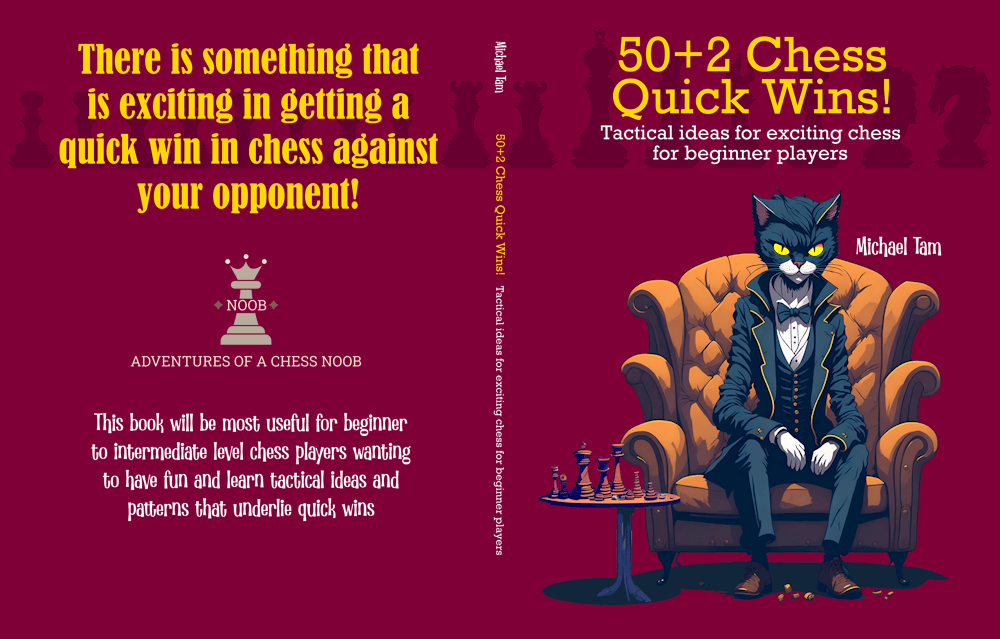
The FOOL-ish MATE | 3 Examples ⚡ Quick Wins #93
#foolsmate #tactics #englundgambit #brilliant #knightsac #quickwins
The Fool’s Mate is the quickest possible checkmate in chess – (1. f3 e5 2. g4 Qh4#) – with White losing at the end of the second turn. However, it’s a contrived quick win as there is no intuitive or natural reason that White would play either of those moves in that order.
The important observation and recognition, however, is the reason why the Fool’s Mate works. Notice that at the beginning of the game:
- The dark square diagonal to the White king (squares f2, g3, h4) are especially vulnerable as these squares are defended only by the king, or by pawns.
- Implicitly, this also means that no pieces other than the king or pawns can occupy these squares in a single move (for instance, to block a check).
- This means if the kingside pawns (f-, g-, and h-pawns) move forward or are removed, there may be no defence of that dark square diagonal!
In this Quick Wins video and article, I present three games of not quite a Fool’s Mate, these are Fool-ish mates, that occurred in actual games!
![]()
Game 1: https://www.chess.com/analysis/library/3XU2pbfexW
This was an unrated 10-min game of rapid where White played an idiosyncratic and freestyle opening. They begin with the Van Geet Opening (1. Nc3), and then play (2. Nh3?!) on the second move. As typical against these sorts of oddities, I just play according to opening principles, in this case, developing both my centre pawns to the middle.
White then showed their logic of (2. Nh3) by playing (3. f4??) next, aiming to pressure my e-pawn. However, this is an immediate blunder! Firstly, they weakened f2 with the f-pawn push. Secondly, I could now capture their knight (3… Bxh3!) with the goal of baiting White to recapture with the g-pawn, which they did (4. gxh3??). The result? We now exposed the dark square diagonal to White’s king, so (4… Qh4#!), a Fool-ish Mate!
![]()
Game 2: https://www.chess.com/analysis/library/3MYUVhZAGE
This was another unrated 10-min game of rapid where the pattern is a little more obscured. The game starts with an Englund Gambit Accepted (1. d4 e5 2. dxe5 Nc6), but where White decided to defend their won e5-pawn with (3. f4). Note that f2 is now weak!
We develop relatively normally for a few moves with White playing (4. Nf3). Note, this defends the h4 square, which prevents Qh4+. So, to try to exploit that weak diagonal, I respond with the aggressive (5… Bg4), which could potentially remove White’s knight if the opportunity arose. And it arose immediately! 🤩
White attempted to kick my bishop with (6. h3??), but this relinquished the defence of the g3 and after (6… Bxf3!), trading my bishop for White’s knight, h4 was no longer defended either! White naturally captured back with (7. gxf3?) and Stockfish identifies that there is a forced checkmate in no more than 9 moves, starting of course with (7… Qh4+!). Should White play accurately from this point, the full checkmate line is rather interesting – dragging White’s king out with check into the centre of the board, crossing over into Black’s territory, and then suffering the indignity of being checkmated by a lowly pawn! (see the PGN below)!
In this game, however, I don’t play the most accurately, but neither does White. Three moves later, White is checkmated by Black’s queen along the diagonal with the dark square bishop assisting by removing an escape square, a Fool-ish Mate!
![]()
Game 3: https://www.chess.com/analysis/library/2HAtVGzLaz
This was a game of 5-min blitz from my subscriber @AndyDeco and was another game of the Englund Gambit but Declined into the Reversed French line (1. d4 e5 2. e3). The last previous game, the initial f-pawn advance by White is more innocent looking (5. f3) can makes some sense in the context of the position, placing pressure on Black’s e4-pawn. Nonetheless, f2 is weakened.
However, after Black responds with (5… Bf5), bolstering their e-pawn, White makes the aggressive, but tactically dubious g-pawn attack on Black’s bishop (6. g4) to chase away the bishop, but in doing so, exposes that dark square diagonal to their king! Every time a pawn moves forward, they leave something behind…
Black recognises the weakness and immediately exploits it with a brilliant knight sacrifice (6… Nxg4!!), opening access for their queen to h4. White captures, thinking they won a free piece, but is then struck with (7. Qh4+)! It’s not quite a Fool-ish checkmate, but close, and it might as well have been as White resigns psychologically defeated. GG!



